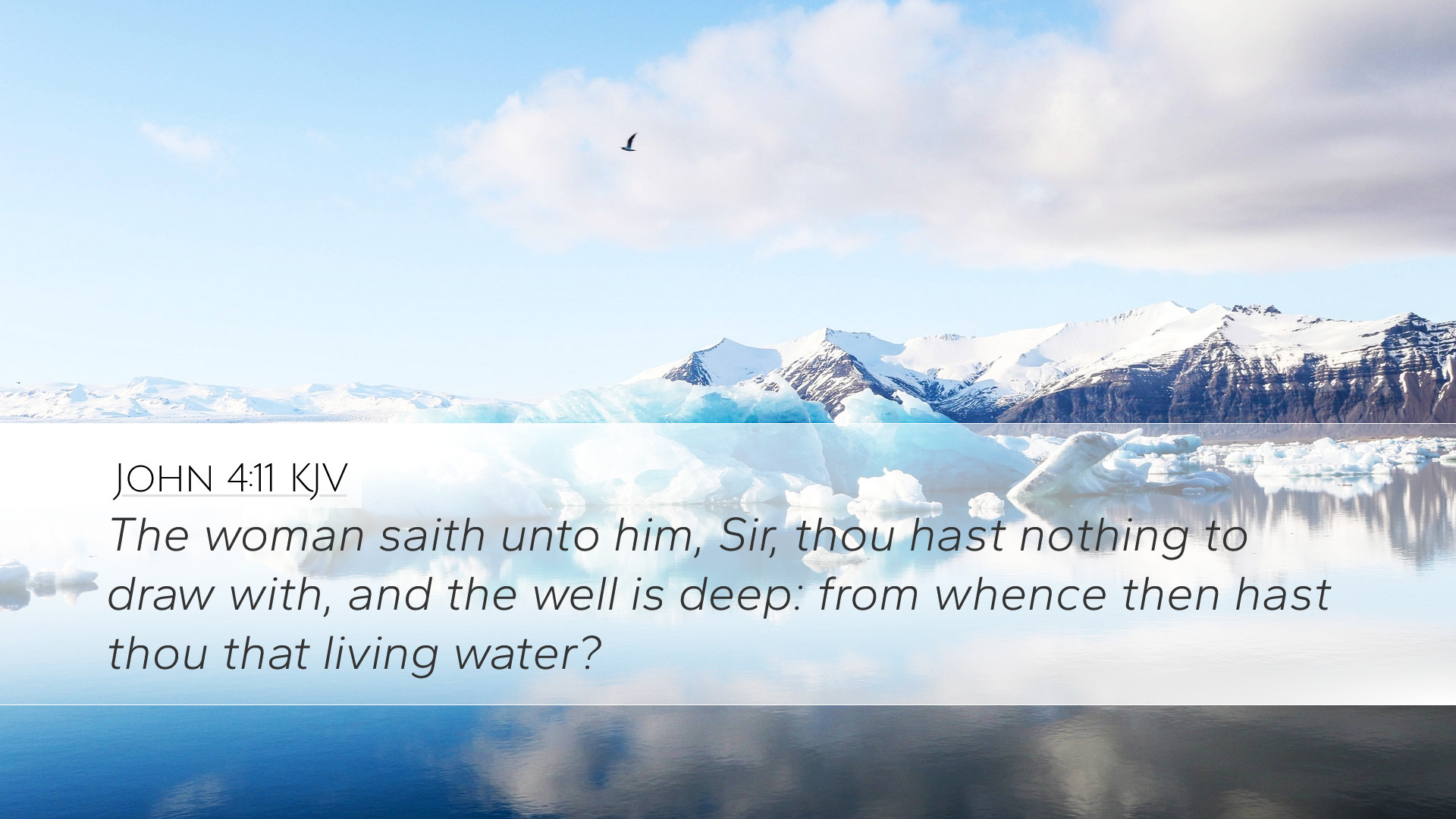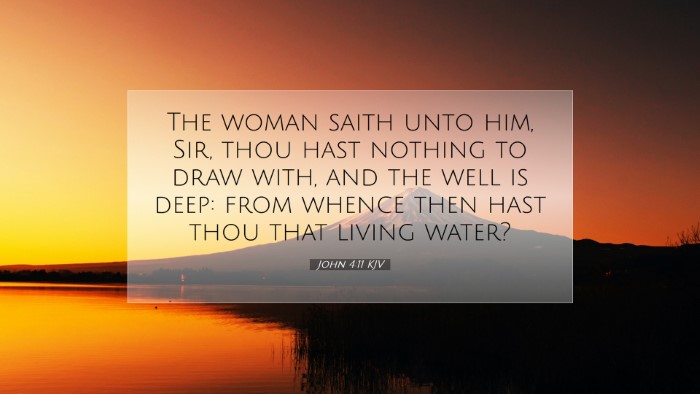Commentary on John 4:11
John 4:11 reads: "The woman said to Him, 'Sir, you have nothing to draw with, and the well is deep. Where then do you get that living water?'" This verse, part of the narrative of Jesus' encounter with the Samaritan woman at the well, opens a profound dialogue about spiritual needs and the nature of true sustenance. In this commentary, we draw from the rich insights of Matthew Henry, Albert Barnes, and Adam Clarke to deepen our understanding of this pivotal exchange.
Contextual Background
The setting for this verse is significant. Jesus, weary from His journey, stops at Jacob's well, a historical landmark that carries deep cultural and spiritual meaning for the Jews and Samaritans alike. The interaction occurs in a land often marked by social and religious division, highlighting the breaking of traditional barriers as Jesus engages with a Samaritan woman. This context enriches the reading of verse 11 as it exemplifies Jesus' mission to seek and save the lost, transcending ethnic and gender barriers.
Literal Interpretation
In her response, the woman highlights two critical points: the absence of a means to draw water and the depth of the well. Her comment can be viewed as both a literal inquiry about the physical water supply and a deeper metaphorical challenge to Jesus' claims about "living water."
The Woman's Skepticism
The woman's skepticism is palpable. She addresses Jesus as "Sir," a term of respect, yet questions His ability to provide the supposed living water. Matthew Henry notes that her question reflects a common human condition—doubt and incredulity when faced with spiritual truths. This interaction invites reflection on our own responses to divine promises.
Understanding 'Living Water'
Albert Barnes points out that the term "living water" signifies a spiritual refreshment and sustenance that contrasts sharply with the ordinary water from the well. The depth of the well symbolically represents the profound nature of the spiritual thirst that Jesus aims to satisfy. The physical depth mirrors the spiritual depths of humanity's condition—thirsting for something more than temporary relief.
Theological Implications
The text encourages a deeper theological reflection on what Jesus means by "living water." Adam Clarke suggests that this term encapsulates the grace of God and the Holy Spirit as a source of eternal life and vitality. It invites the reader to consider personal spiritual thirst and the adequacy of worldly solutions versus divine provision.
The Symbolism of Water
- Physical vs. Spiritual: Water has historically been a symbol of purification and life in biblical texts. Jesus uses this familiar symbol to indicate a transformative spiritual experience.
- Accessible to All: The dialogue emphasizes that access to this living water is not limited by societal constraints—anyone, including those marginalized by society like the woman in question, can partake.
Application to Believers
As contemporary readers, this verse prompts self-examination regarding our perceptions of Christ’s ability to meet our deepest needs. Pastors, theologians, and students are challenged to articulate the gospel in ways that resonate with the spiritual thirst of their communities. Applying insights from Henry and Clarke, we should encourage an understanding of faith that embraces questions and doubts, just as the Samaritan woman expresses hers. Furthermore, the church's invitation to individuals struggling with faith should echo Christ's approach—inclusive and transformative.
Engaging with Doubt
- Personal Reflection: Like the woman at the well, individuals often confront their own doubts and questions about faith. Creating safe spaces in churches for these discussions allows believers to explore their spiritual journeys.
- Community Outreach: The church’s mission to provide "living water" should emphasize holistic needs—physical, emotional, and spiritual through compassionate outreach and support.
Conclusion
John 4:11 serves as an invitation to delve deeper into the nature of Jesus as the provider of living water. The interplay of doubt, questioning, and yearning for spiritual fulfillment is timeless. Drawing from the insights of Matthew Henry, Albert Barnes, and Adam Clarke enriches our understanding and application of this text, urging us towards a more profound engagement with our faith and our communities. It encourages believers to guide others, much like Christ did, toward the eternal sustenance found in Him.


